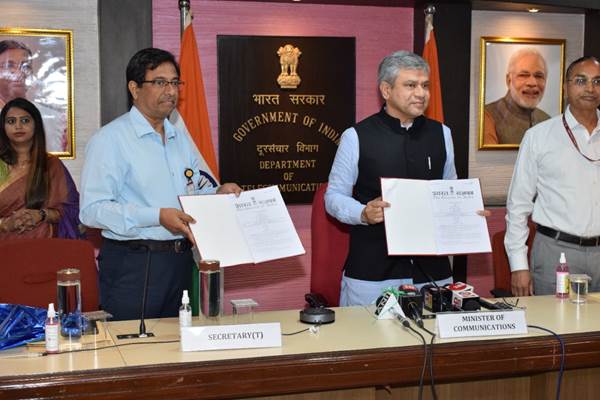Ministry of Communications
Gati-Shakti Vision for Telecom Infrastructure – Right of Way Rules Amended for Faster 5G Roll-out
प्रविष्टि तिथि:
25 AUG 2022 7:48PM by PIB Delhi
In an event organised by the Department of Telecommunications, Shri Ashwini Vaishnaw, Union Minister of Communications, Electronics & IT and Railways released amendment in the Indian Telegraph Right of Way (RoW) Rules, 2016 to facilitate faster and easier deployment of Telecom Infrastructure and launched a new 5G RoW application 'form’ on GatiShakti Sanchar Portal to enable faster 5G roll-out in India. Shri K Rajaraman, Chairman DCC & Secretary (T), senior officials of Department of Telecommunications and representatives of industry were present.

In his address, Shri Ashwini Vaishnaw mentioned about the 4 basic ingredients for ensuring faster rollout of 5G services across the country, mainly allocation of spectrum, reforms in the processing of RoW permission, co-operative federalism and rollout of services. Spectrum allocation and harmonization has been completed successfully. GatiSakti Sanchar Portal was launched by DoT in May, 2022 in line with Hon’ble PM’s vision of development of infrastructure services in an integrated manner. The IT systems of all States/UTs and major infrastructure central ministries such as Railway, Highways have been integrated with the portal to make India ready for 5G launch. Hon’ble Minister also commended State Governments & UTs for their work on RoW policy alignment. He also mentioned that 13 States/UTs have also implemented deemed approval clause in their RoW Policies ensuring speedy approvals. These measures have resulted in major reduction in average time for approval of RoW applications, from 435 days in 2019 to 16 days in July, 2022.
He further mentioned that in the amended Right of Way Rules, charges for RoW permissions have been made reasonable and a ceiling for RoW charges for installation of 5G small cells and optical fibre cable on street furniture has been fixed. These amendments will pave the way for deployment of 5G small cells on existing street infrastructure. With these series of reforms, the country is now ready for launch of 5G services by October, 2022.
The salient features of the amendments are as follows:
Expansion of telecom infrastructure:
- To facilitate faster 5G roll-out, RoW application procedures for small cell has now been simplified. Telecom licensees will be able to use street infrastructure to deploy telecom equipment at a nominal cost of Rs. 150/annum in rural areas and Rs. 300/annum in urban areas.
- To facilitate faster fiberisation, street infrastructure may be utilized at a nominal cost of Rs. 100/annum to install overground optical fibre.
- The amendments create distinction between ‘poles’ and ‘mobile towers’. Overground infrastructure of height up to 8 meters shall be treated as poles and will need minimal regulatory permissions for deployment.
Improving ease of doing business:
- Telecom licensees had to submit RoW applications on different platforms of State/UTs. The amendments provide for a single window clearance system for RoW applications. Gati Shakti Sanchar Portal of Ministry of Communications will be the single window portal for all telecom related RoW applications.
- Single window clearance will reduce multiplicity of compliance and facilitate easier approvals.
Rationalization of fees/charges:
- Rationalization of administrative fees: Telecom licensees are required to pay administrative fees for the RoW permissions. As technology improves, significant telecom equipment will be deployed on poles. To reduce the cost of compliance, the administrative fees have been rationalized as follows:
- No administrative fee shall be charged by Central Government or its agencies for establishment of poles on the land owned/controlled by them.
- For State/UTs, the administrative fee for establishment of poles shall be limited to Rs. 1,000 per pole.
- Administrative Fee for laying overground optical fiber shall be limited to Rs. 1,000/ Km.
- Uniformity in calculation of area: Telecom licensees have to pay charges proportionate to the area occupied by telecom infrastructure. At present, different agencies use different methodology to calculate the area. The amendments now prescribe a methodology to calculate the area occupied by telecom infrastructure. This will bring uniformity in computation of area and associated charges for the telecom infrastructure across the country.
- Rationalizing cost of restoration: In case of restoration, Telecom licensees either have to undertake the restoration themselves or pay the concerned authority for restoration work. To ease this process, two major reforms have been introduced.
- If the Telecom licensee undertakes the restoration work, a Bank Guarantee amounting to 100% of restoration cost needs to be submitted to the concerned agency. This amount has now been rationalized. Telecom Licensee shall be required to submit a BG for an amount of 20% of the restoration cost only.
- If the Telecom Licensee wishes to pay the concerned agencies, the cost of restoration shall be calculated at the rates prescribed by Central Public Works Department (CPWD) or Public Works Department (PWD) of the State/UTs.
- No compensation for establishment of poles: Telecom licensees shall not be required to pay compensation for land for establishment of poles.
- Incentivizing use of technology: Technology is now available for laying Optical Fiber without digging a full trench. Therefore, in case of fiber laid using horizontal directional digging technology, Telecom Licensee shall have to pay restoration charges only for the pits, and not for the entire route.
- These reform measures are aimed at bringing down the time and cost of deployment of telecom infrastructure.
Telecom infrastructure over private property:
- For installing telecom infrastructure on private property, Telecom licensees may enter into agreement with private property owners and they will not require any permission from any government authority.
- In such cases, Telecom licensees shall be required to give only prior intimation along with structural suitability certificate.
These measures are expected to facilitate rapid expansion and upgradation of telecom networks and therefore improvement in the quality of services.
***
RKJ/M
(रिलीज़ आईडी: 1854472)
आगंतुक पटल : 5837